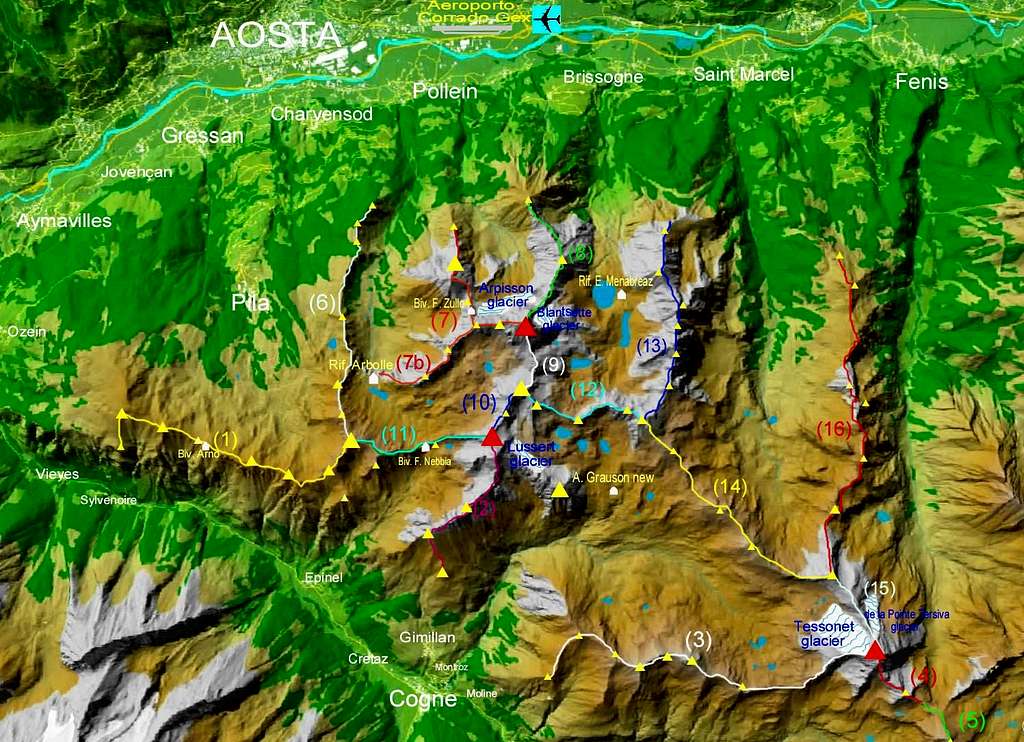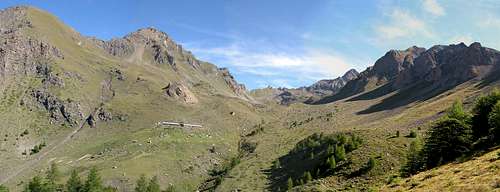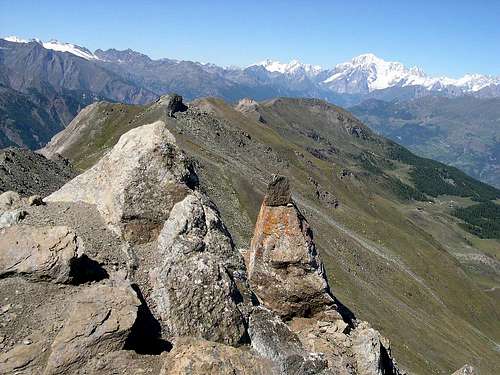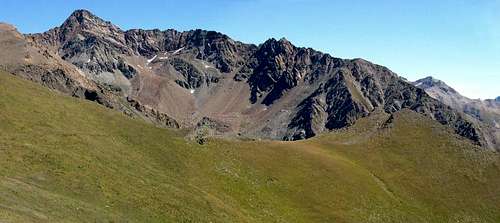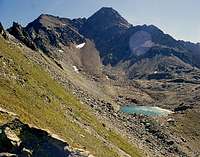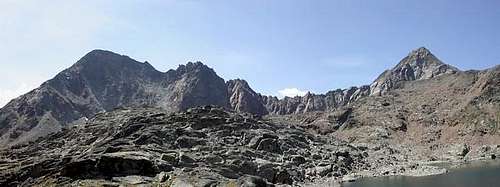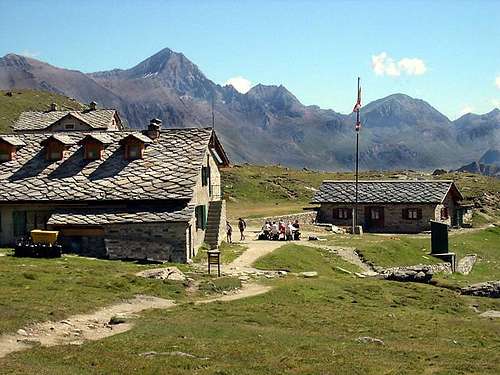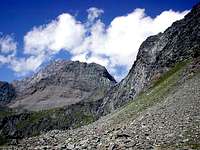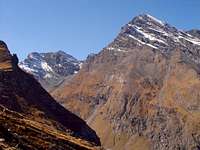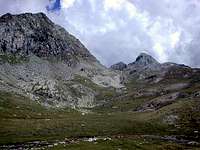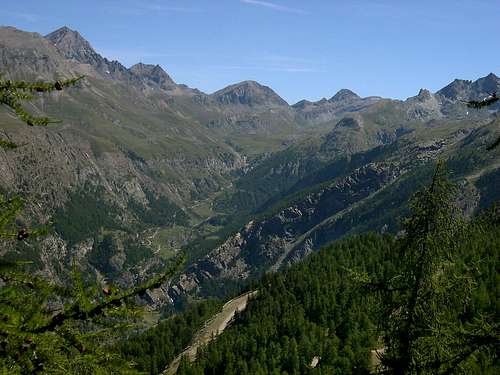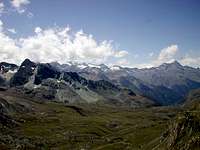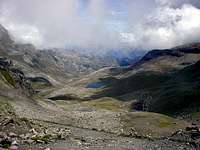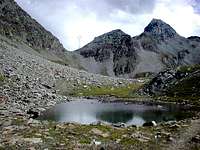-
 7392 Hits
7392 Hits
-
 84.27% Score
84.27% Score
-
 18 Votes
18 Votes
|
|
Area/Range |
|---|---|
|
|
45.67790°N / 7.40479°E |
|
|
Hiking, Mountaineering |
|
|
Spring, Summer, Fall, Winter |
|
|
Overview
- From the north by the main valley, between the Villages of Saint Marcel and Aymavilles. The Dora Baltea River runs through the valley.
- From the south and the west by Vallone dell'Urtier (vallone means hanging valley) and Valle di Cogne. The Grand Eyvia creek runs through the latter and, in Aymavilles, flows into Dora Baltea.
- From the east by Vallone di Clavalitè, which also forms the western boundary of the group known as "Mont Glacier, Mont Avic e Rosa dei Banchi".
- From the southeast, very briefly, by Vallone di Champorcher, in the stretch of the ridge between Col Pontonnet and Finestra di Champorcher.
- Vallone di Laures (or Brissogne) under the East face of Monte Emilius.
- Vallone di Arpisson, at whose head is the North face of Emilius.
- Vallone di Comboè, which, after a cliff, suddenly changes direction (from north-south to east-west) and-going around the western spur that descends from the Emilius Summit to Petit Emilius and Mont Ross de Comboè--forms Comba di Arbolle (or Arbole).
- Vallone di Arpisson (di Cogne) or Pian Bessey
- The long and vast Vallone di Grauson, mostly above 2.400m of elevation.
Getting There
 |
BY CAR:
- From Torino, Milano, etc: Motorway A5. Exit at Aosta Ovest. Drive to the nearby Aymavilles. Follow the directions for Valle di Cogne.
- From Switzerland: through the Grand Saint Bernard Tunnel or the namesake pass. Drive to Aosta, then follow the direction for Courmayeur on SS.26. Just after Sarre, turn left, in the direction of Valle di Cogne.
- From France: through Mont Blanc Tunnel or Petit Saint Bernard Pass. It is not necessary to take Motorway A5: you can drive on SS.26, in the direction of Aosta. Before arriving at the Village of Sarre, turn right following the sign for Valle di Cogne. Starting from Cogne there are two possibilities: Follow the road signs for Gimillan and Lillaz; arrived at a roundabout, recently built in proximity of the St. Anthony Chapel, go left along the scenic route leading to the Village of Gimillan (1.787m), 3 Km. after Cogne. Usually no parking problem. From here you can get many spots of the Monte Emilius Group:the ridge between Valle di Cogne and Pila Basin, the Vallone di Pian Bessey, the ridge between Vallone di Pian Bessey and Vallone di Grauson, Vallone di Grauson-Lussert.
- Going right at the roundabout, after 3 Km. the road arrives at the Village of Lillaz (1.615m), famous for his wonderful waterfalls. From Lillaz starts an unpaved and rough road, appropriately closed to the cars (except 2-3 days in August, on the occasion of San Besso and Madonna delle Nevi festivities). It follows all the long Urtier Valley as far as the recently built Sogno di Berdzè Hut (2.526m), at the foot of Finestra di Champorcher (2.828m), a pass connecting the Urtier and Champorcher Valleys. From the head of Urtier Valley, through Passo d'Invergneux you get directly the head of Grauson Valley, just at the foot of Punta Tersiva. If you want instead to get to Pila: starting from the City of Aosta, follow the sign for Pila: a long and winding road will lead you from Aosta (583m) to Pila (about 1.800m). Pila is the starting point nearest to the Emilius Summit.
Cogne and Pila are reachable also by public transportation. In addition, there is a cableway connecting directly Aosta to Pila.
BY PLANE:
- Aeroporto "Corrado Gex" Saint Christophe (Aosta).
Summits and Passes of the GROUP: Second Part
In the southern sector, consisting of Valle di Cogne and its secondary valleys:
- Vallone dell'Urtier
Vallone di Grauson
- Vallone d'Arpisson (Cogne)
1) Ridge between Valle di Cogne and Conca di Pila
- Punta de la Pierre (2.653 m)
- Punta Vadaille (2.339 m)
- Col de la Pierre (2.600 m)
- Punta del Drinc (2.663 m)
- Colle del Drinc (2.555 m)
- Punta del Couis (2.661 m)
- Colle del Couis (2.637 m)
- Piatta di Grevon (2.756 m)
- Punta di Mompers (2.793 m)
- Colle di Mompers (2.750 m)
- Pointe Tsasetze (2.826 m)
- Colle Tsasetze (2.820 m)
- Punta della Valletta (3.090 m)
- Punta di Tzavanis (2.815 m)
2) Ridge between Vallone di Arpisson (Cogne) and Vallone di Grauson
- Punta Tsaplana (2.678 m)
- Punta di Arpisson (3.031 m)
- Col di Pila S-W (3.028 m) and N-E (3.090 m)
- Punta Coppi or Pointes Coupées d'Arpisson (SW 3.231 m, Centrale 3.220 m, NE 3.215 m)
- Torre di Arpisson (3.231 m)
- Col Fleurie (3.170 m)
- Punta di Lavà (three summits: 3.214 m)
- Punta Fleurie (3.258 m)
- Punta Garin (3.451 m)
- Notch of Punta Garin (3.245 m)
- Mont Valaisan (3.296 m)
2b) Ridge connecting Punta Garin (3.245 m) and Mont Grauson (3.240 m)
- Punta Garin (3.451 m)
- Gendarme del Grauson (3.224 m)
- Passo del Grauson (3.109 m)
- Mont Grauson (3.240 m)
3) Ridge between Vallone di Grauson-Doreire and Vallone dell'Urtier
- Montzalet (2.759 m)
- Mont Creya (3.015 m)
- Testa di Money (3.130 m)
- Punta Coupé (3.214 m)
- Penne Blanche (Punta E. 3.254 m, Punta W. 3.208 m)
- Testa di Vallonet (3.135 m)
- Colle Vallonet (3.062 m)
- Passo d'Invergneux (2.902 m)
- Punta Tersiva (3.515 m)
4) Ridge between Vallone dell'Urtier and Vallone di Clavalitè
- Punta Tersiva (3.515 m)
- Torre Pontonnet (Punta S. 3.173 m, Punta N. 3.185 m)
- Colle Pontonnet (2.897 m)
- Torre Ponton (3.101 m)
5) Ridge between Vallone dell'Urtier and Vallone di Champorcher
- Torre Ponton (3.101 m)
- Finestra di Champorcher (2.826 m)
- Bec Costazza (3.092 m)
- Sella (2.946 m)
- Quota (2.978 m)
- Cima di Peradzà (3.021 m)
Inside Vallone di Grauson-Lussert-Doreire
- Testa di Prà di Ler (2.525 m)
- Testa Vareri (2.638 m)
- Punta di Tsesère (3.105 m)
- Testa Doreire (2.888 m)
- Puy Vardettaz (2.579 m)
Punta di Ervillères (2.790 m)
Mountain Conditions
- You can get meteo information at the official site of the Regione Valle d'Aosta
- Valle d'Aosta Meteo
Webcam
- WEBCAM on Aosta Valley:
- Webcam
Campings
Books and Maps
BOOKS:
- "Guida delle Alpi Occidentali" di Giovanni Bobba e Luigi Vaccarone C.A.I. Sezione di Torino Volume II (parte II), 25 Maggio 1896.
- "Guida della Valle di Champorcher" e "Guida della Valle di Cogne" di Mario Aldrovandi Ed. Lattes, Torino 1930-1932.
- "Guida della Regione Autonoma Valle d'Aosta" di Mario Aldrovandi; Ed. S.P.E. di Carlo Fanton, Torino 1964.
- "Ascensioni 1964-1969 Diario Alpinistico di Ilario Antonio Garzotto (unpublished).
- "Guida del Monte Emilius" di Osvaldo Cardellina Editore in collaborazione con il Club Alpino Italiano Sezione di Aosta, Dicembre 1978 (in Italian).
- "Guida dei Monti d'Italia–Emilius Rosa dei Banchi Parco del Mont Avic" di Giulio Berutto e Lino Fornelli-Club Alpino Italiano/Touring Club Italiano, Marzo 2005 (in Italian).
- "Diari Alpinistici" di Osvaldo Cardellina e Indice Generale accompagnato da Schedario Relazioni Ascensioni 1964-2019 (inediti).
- "80 itinerari di Escursionismo Alpinismo e Sci Alpinismo in Valle d’Aosta", di Osvaldo Cardellina, Ed. Musumeci, Giugno 1977 (in Italian); seconda Ed. Luglio 1981; terza Ed. Luglio 1984; (in French), prima Ed. Febbraio 1978; seconda Ed. Marzo 1980.
- "Il Parco Nazionale del Gran Paradiso (Valli di Champorcher-Clavalitè-Saint Marcel-Laures-Cogne-Valsavarenche-Conca di Pila" di Giulio Berruto 3/volume 2°, IGC, Torino 1981, 2a Ed. 2000. (in Italian).
- "Ascensioni in Valle d'Aosta 1921-1933" Diario Alpinistico di Amilcare Crétier; Edizione Sezione di Verres del C.A.I. e Biblioteca di Vèrres, stampa Arti Grafiche Tamari Bologna, Luglio 1993 (in Italian).
MAPS:
- Kompass "Gran Paradiso Valle d'Aosta Sentieri e Rifugi" Carta Turistica 1:50.000.
- Hapax Luglio 2000 "Les Sentiers Comunità Montana Monte Emilius" 1:25.000.
- Enrico Editore Ivrea-Aosta "Gruppo del Gran Paradiso" 1:50.000.
- I.G.C. Torino "Carta delle Passeggiate ed Escursioni in V.D.A. Conca di Pila-Gressan" 1:20.000.
Important Information
- REGIONE AUTONOMA VALLE D'AOSTA the official site.
- FONDAZIONE MONTAGNA SICURA Villa Cameron, località Villard de la Palud n° 1 Courmayeur (AO) Tel: 39 0165 897602 - Fax: 39 0165 897647.
- SOCIETA' GUIDE ALPINE DI COGNE Tel. 347/9473526 – 328/1373728.
- A.I.NE.VA. (Associazione Interregionale Neve e Valanghe).
- A.IA.T. Cogne Gran Paradis via Bourgeois n° 34 Tel. 0165-74040. E-mail: aiat@cogne.org
- Ezio Sport articoli sportivi - via Bourgeois n° 64 Tel. 0165-74204.
Useful Numbers
- Soccorso Alpino Cogne (SAR) Tel. 3482685406.
- Protezione Civile Valdostana località aeroporto n° 7/A Saint Christophe (Ao) Tel. 0165-238222.
- Bollettino Meteo (weather info) Tel. 0165-44113.
- Unità Operativa di Soccorso Sanitario Tel. 118.
Acknowledgements
The fundamental support given by my friend Osvaldo Cardellina, probably the best connoisseur of every feature of the Monte Emilius Group (of which he climbed nearly every summit,wall and ridge) has to be emphasized.
I want to thank also Fabio (Brenta) for the translation of the text from Italian and livioz for his contribution to the preparation and editing of the page.



